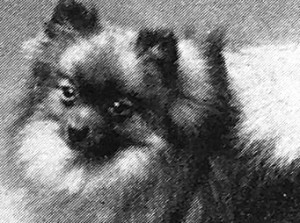Adapt, Change…Survive – The Story of the Pomeranian
130 – September, 2017
By Lee Connor
It is not the strongest of the species that survives, nor the most intelligent. It is the one that is most adaptable to change.
– Charles Darwin
 All our toy breeds have fascinating histories but none demonstrate the skill, ingenuity and adaptability of pedigree dog breeders quite so well as the history of the Pomeranian.
All our toy breeds have fascinating histories but none demonstrate the skill, ingenuity and adaptability of pedigree dog breeders quite so well as the history of the Pomeranian.
You see, the Pomeranian our Victorian ancestors knew was a very different dog from the colourful, self-assured midgets we know today; the Pom of their day was a dog of moderate size, somewhat resembling a Keeshond.
The arrival of this breed into England was not hailed by dog lovers with any degree of friendliness. Indeed, they had no time for it and were horrified at a type of dog that did not seem (to them) to have any sporting value, and consequently, in their opinion, compared most unfavorably with the British sporting breeds such as the Greyhound, Pointers, Setters, Hounds and Spaniels. Of course, much of this prejudice was distinctly insular because the Pomeranian was, after all, a ‘foreigner’ and the more said against it the better – it was simply not wanted here amongst ‘the British breeds’.
Some of the early commentators were particularly scathing. Taplin, in the Sportsman’s Cabinet (1803) was bitterly opposed to the breed. He wrote, ‘In general opinion as a house dog he is held in but slender estimation, being by nature frivolous, artful, quarrelsome, cowardly, petulant, deceitful, snappish and dangerous with children, without one property to recommend him.’ Vero Shaw opened his chapter on the breed with these devastating lines: ‘The Pomeranian is admittedly one of the least interesting dogs in existence, and consequently his supporters are few and far between.’
Yes, much of what these experts wrote was fueled by prejudice but we also have to put ourselves in the mindset of those far off times, times when it would have been deemed quite unusual to have spent any time brushing your dog…the coat was simply allowed to grow how it pleased and consequently would often become tangled and matted. When such a coat became intolerable, it was simply shorn off. Any reader who has ever seen a spitz-type dog in bad coat or neglected would realize what a sad, deplorable spectacle those early dogs must have made.
But despite such a continuous onslaught of loathing (and with so many of the leading authorities brazenly against the breed, it is a wonder the Pomeranian did not die out altogether) but a few people must have seen something special in these early dogs… and this little band of enthusiasts rigidly stuck to their guns and persevered with their much-maligned Poms.
Click here to read the complete article130 – September, 2017
Short URL: https://caninechronicle.com/?p=131825
Comments are closed











